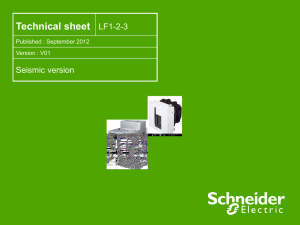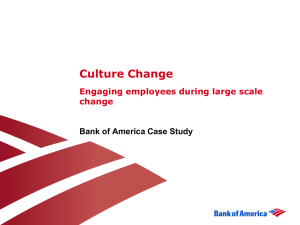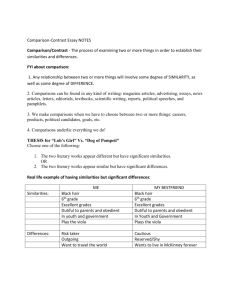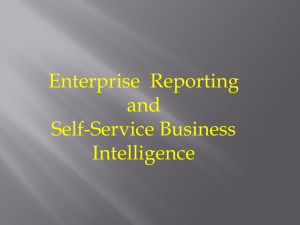Knowledge Management
advertisement
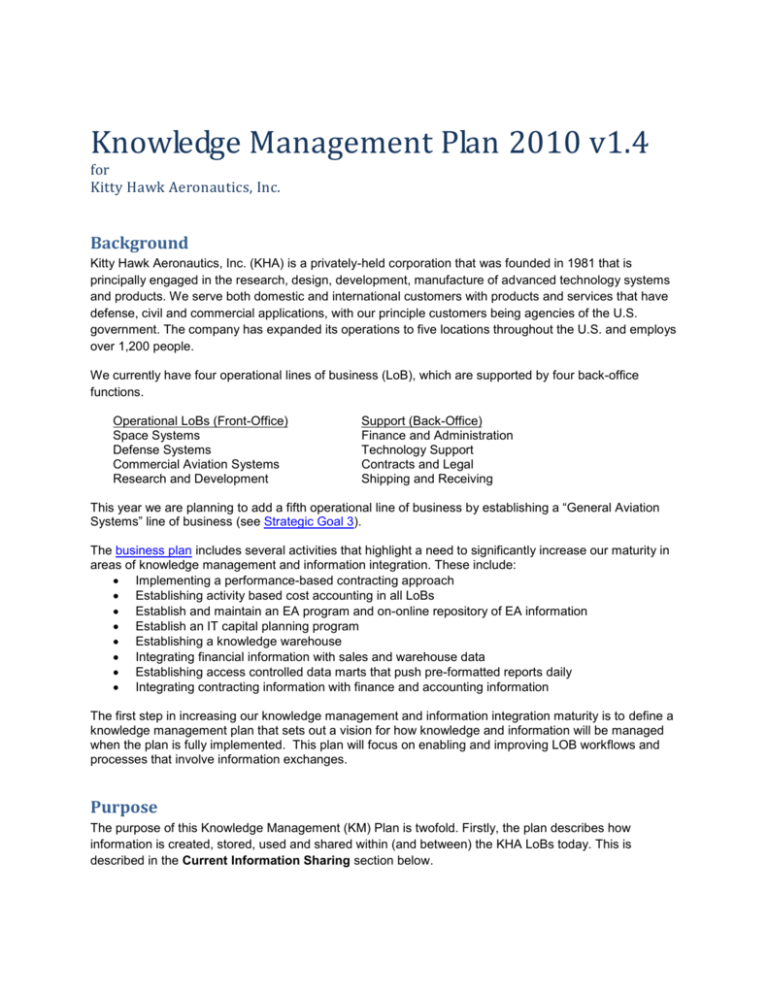
Knowledge Management Plan 2010 v1.4 for Kitty Hawk Aeronautics, Inc. Background Kitty Hawk Aeronautics, Inc. (KHA) is a privately-held corporation that was founded in 1981 that is principally engaged in the research, design, development, manufacture of advanced technology systems and products. We serve both domestic and international customers with products and services that have defense, civil and commercial applications, with our principle customers being agencies of the U.S. government. The company has expanded its operations to five locations throughout the U.S. and employs over 1,200 people. We currently have four operational lines of business (LoB), which are supported by four back-office functions. Operational LoBs (Front-Office) Space Systems Defense Systems Commercial Aviation Systems Research and Development Support (Back-Office) Finance and Administration Technology Support Contracts and Legal Shipping and Receiving This year we are planning to add a fifth operational line of business by establishing a “General Aviation Systems” line of business (see Strategic Goal 3). The business plan includes several activities that highlight a need to significantly increase our maturity in areas of knowledge management and information integration. These include: Implementing a performance-based contracting approach Establishing activity based cost accounting in all LoBs Establish and maintain an EA program and on-online repository of EA information Establish an IT capital planning program Establishing a knowledge warehouse Integrating financial information with sales and warehouse data Establishing access controlled data marts that push pre-formatted reports daily Integrating contracting information with finance and accounting information The first step in increasing our knowledge management and information integration maturity is to define a knowledge management plan that sets out a vision for how knowledge and information will be managed when the plan is fully implemented. This plan will focus on enabling and improving LOB workflows and processes that involve information exchanges. Purpose The purpose of this Knowledge Management (KM) Plan is twofold. Firstly, the plan describes how information is created, stored, used and shared within (and between) the KHA LoBs today. This is described in the Current Information Sharing section below. The second purpose of the KM plan is to propose an enterprise-wide approach to the management and maintenance of knowledge, information and data in KHA that supports the key business activities defined above. This new approach is described in The Vision for Information Sharing section below. Current Information Sharing Customer Suppliers Order Information Space Systems Financial data Finance & Administration KM Area Information Strategy Defense Systems Part Information Commercial Aviation Systems ICT information Legal information Technology Support Contracts & Legal Research & Development Shipment data Shipping & Receiving Current Situation There is no information strategy. There is no visibility to how an information strategy might support the business plan. It is not clear how the organisation collects, stores, analyses, searches, uses, and disseminates information, in all its forms. There are a few information-related policies and guidelines but there are no processes in place to regularly review and, if necessary, update them. Management of Information There is no consistent approach to managing information. Each of the LoBs is responsible for managing and maintaining their own information. Primarily, data exists within operational databases as part of individual IT systems within each LoB. There are no information-related standards, guidelines and policies. The defacto standards are driven by the IT systems being used. There are informal approaches to document management, records management, content management, learning management, etc. KM Area Sharing of Information Current Situation The approach to information sharing is ad-hoc and chaotic. Generally, the organisation suffers from the “not invented here” syndrome. The operational LoBs operate as separate, isolated silos and information from other operational LoB is not seen as useful or relevant. Processes, procedures, guidelines and innovations that could be leveraged across the organisation are not. Financial, shipment, contract and technology related information is exchanged with back office functions using a variety of formats, with little or no standardisation. Lifecycle of Information Security of Information Billing, product, part and order related information is exchanged with external organisations, primarily suppliers and customers. Again, various information formats are used, with little or no standardisation. The approach to data retention and archiving is not consistent. Each operational LoB implements its own information lifecycle. Most have an ad-hoc approach that is largely driven by the IT systems being used and by their key customers’ requirements. There is no consistency to the approach to securing information within the enterprise. Each LoB is responsible for its own information security. Generally, the information security mechanisms implemented direct reflect the requirements of their key customers. However, these security requirements are not reflected in the back office functions, where information security is entirely driven by the IT systems being used. The Vision for Information Sharing Space Systems Defense Systems Commercial Aviation Systems Research & Development Back Office Back Office Functions BackFunctions Office Functions General Aviation Systems Knowledge Management Systems Document Management Learning Management Content Management Reporting Searching & Indexing Intranet … Knowledge Information Warehouse Accessing & Mining Documents & Content Data Marts Data Marts Data Marts … … Operational Systems ETL/Organizing ETL/Organizing Operational Systems The approach consists of a knowledge warehouse (KWH) that is run by the office of the CIO, based on an architecture that the KHA EA team will design with participation by LoB managers and other key stakeholders. Implementation of the KWH will be accomplished in conjunction with the implementation of an enterprise service bus to enable and enhance the sharing of information and data within and between all KHA LoBs. Benefits of a KWH approach include: Standardisation of information and data formats lifecycles and security classifications is enforced through a common KWH Creation of knowledge base that can be shared throughout KHA Consistency, integrity and quality of information is improved through a common KWH Information and knowledge sharing is facilitated by a shared KWH that is the authoritative source of integrated information, both current and historical Ability to view information across LoB and business function boundaries is enhanced by a shared KWH that integrates various information sources into a single, coherent information view (e.g. integrates financial information with sales and warehouse data, integrates contract information with finance and accounting information) Supports establishment of access controlled data marts that push pre-formatted reports daily Elimination of redundant/duplicate information flows and data stores by consolidating various sources of information into the KWH Supports the use of shared, common knowledge management (and other) systems throughout KHA To implement the KWH, the following high-level activities will be undertaken: Define information (and knowledge) usage and dissemination patterns within and between LoBs and business functions Define a knowledge strategy that supports the business plan, including a roadmap Identify and source appropriate knowledge management tools and capabilities to facilitate strategy Provide knowledge management training & business change support in line with the strategy Implement new knowledge management tools and capabilities as defined by the roadmap Transition to new knowledge management tools as defined by the roadmap Mentor and train staff throughout the transition period KM Area Knowledge Strategy Future Situation A Knowledge Strategy will be defined that clearly demonstrates how the knowledge strategy supports the business plan and how the organisation collects, stores, analyses, searches, uses, and disseminates knowledge, in all its forms. Specifically, the strategy must demonstrate how these key business activities are supported: Implementing a performance-based contracting approach Establishing activity based cost accounting in all LoBs Establish and maintain an EA program and on-online repository of EA information Establish an IT capital planning program Establishing a knowledge warehouse Integrating financial information with sales and warehouse data Establishing access controlled data marts that push pre-formatted reports daily Integrating contracting information with finance and accounting information KM Area Future Situation Management of Knowledge A Knowledge Warehouse (KWH) will contain all knowledge across the enterprise, unless security needs dictate otherwise (e.g. top secret data won’t be put into the KWH). The KWH will be run by the office of the CIO. Access to the KWH will be through the EA repository. Sharing of Knowledge Knowledge and information management tools, policies and procedures will be implemented and shared throughout the organisation. Each LoB and business function will obtain the necessary data, information and knowledge from the KWH. Within security constraints, knowledge in the KWH will be available to all LoB and business functions. Datamarts will be established that facilitate information sharing throughout the enterprise, particularly in support of automated report generation and distribution. Refer to KHA Information Exchange Matrix Lifecycle of knowledge Security of Information Information Lifecycle classifications will be created and lifecycle management rules and policies, including data retention rules, will be defined for each classification. All information will have an information lifecycle classification. Shared, common tools for the management of information lifecycles will be implemented. Review of these lifecycle classifications will occur on a regular basis (e.g every 3 years) Information Security classifications will be created and appropriate rules and policies will be implemented. All information will have an information security classification. Shared, common tools for the management of information security will be implemented. Monitoring of these classifications, rules and policies will occur on a regular basis (e.g. every 3 years). Space Systems: The Vision Realised The diagram below, along with the supporting table, show the rich and varied types of information that will be shared between the Space Systems LoB , the other LoBs, back office functions, customers and suppliers via the Knowledge Warehouse. Once in the Knowledge Warehouse, the information is available to any LoB or back office function and may be integrated in a variety of views as needed. For example, it will be possible to generate integrated views of the finance, sales and warehousing information or the contract, finance and accounting information. Customer Requests for Quote Order Requests, Component Requirements, Feasibility Assessments Quotations, Component Specifications & Assessment findings Actual Expenditures, Forecasts, Approvals Research findings and innovations Research & Development Finance & Administration Budgets, Financial Advice Research requests Technology Requirements Space Systems Other LoBs Defense Systems LoB Commercial Aviation General Systems LoB Aviation Systems LoB Innovations, Processes, Procedures, Guidelines Line of Business Technology Support ICT infrastructure, Policies & Support Requests for Opinions & Validation Contracts & Legal Opinions, Guidelines & Requirements Innovations, Processes, Procedures, Guidelines Fulfilled Orders Shipping & Receiving Supplier Parts Shape Legend: Business function Line of business External party Orders, Part Component Requirements Part component specifications Supplier Grouping of LoBs From Customer To Space Systems LoB Description The Customer provides a set of requirements for the component(s) it wants manufactured. The Customer may also request feasibility assessments for components ideas. Once Space Systems is able to manufacture the From To Space Systems LoB Customer Space Systems LoB Research & Development LoB Research & Space Systems LoB Development (R&D) LoB Space Systems LoB Defense Systems LoB Defense Systems LoB Space Systems LoB Space Systems LoB Commercial Aviation Systems LoB Commercial Aviation Systems LoB Space Systems LoB Space Systems LoB General Aviation Systems LoB General Aviation Systems LoB Space Systems LoB Space Systems LoB Supplier Supplier Space Systems LoB Space Systems LoB Shipping & Receiving Shipping & Receiving Space Systems LoB Space Systems LoB Finance & Administration 1 Description component, the Customer is able to place orders for the component. Space Systems transforms the component requirements into a comprehensive specification of the component and provides it to the Customer for validation.1 Space Systems also informs the customer of the results of the requested feasibility assessment. Space Systems sometimes has a need to request research in specific areas, generally as a result of a customer’s request for a feasibility study. R&D provides Space Systems access to the results and progress for research. Information about Space Systems innovations, processes, procedures and guidelines are shared with Defense Systems. Information about Defense Systems innovations, processes, procedures and guidelines are shared with Space Systems. Information about Space Systems innovations, processes, procedures and guidelines are shared with Commercial Aviation Systems. Information about Commercial Aviation Systems innovations, processes, procedures and guidelines are shared with Space Systems. Information about Space Systems innovations, processes, procedures and guidelines are shared with General Aviation Systems. Information about General Aviation Systems innovations, processes, procedures and guidelines are shared with Space Systems. Specifications for part(s) being supplied.2 Space systems supplies a set of requirements for part(s) needed to create the component. The Supplier transforms the part requirements into a comprehensive specification of the part. Fulfilled orders need to be shipped to the customer. Parts received from suppliers are received and delivered to Space Systems. Financial information about the current and planned expenditure for Space Systems is provided to The components themselves are not included in this information. They are an information flow to Shipping & Receiving. 2 The parts themselves are not included in this information flow. They are an information flow from Shipping & Receiving. From To Finance & Administration Space Systems LoB Space Systems LoB Contracts & Legal Space Systems LoB Space Systems LoB Technology Support Technology Support Space System LoB Contracts & Legal Description Finance & Administration. Finance & Administration update the budget and provide advice to Space Systems. Space Systems requests legal opinions and contract validation from Contracts & Legal. Contracts & Legal provide the requested opinion and validation. They also provide the guidelines and legislative/policy requirements for the Space Systems. Space Systems provides requirements for the technology support needed for any change. Technology Support provides the ICT infrastructure, policies and support.

